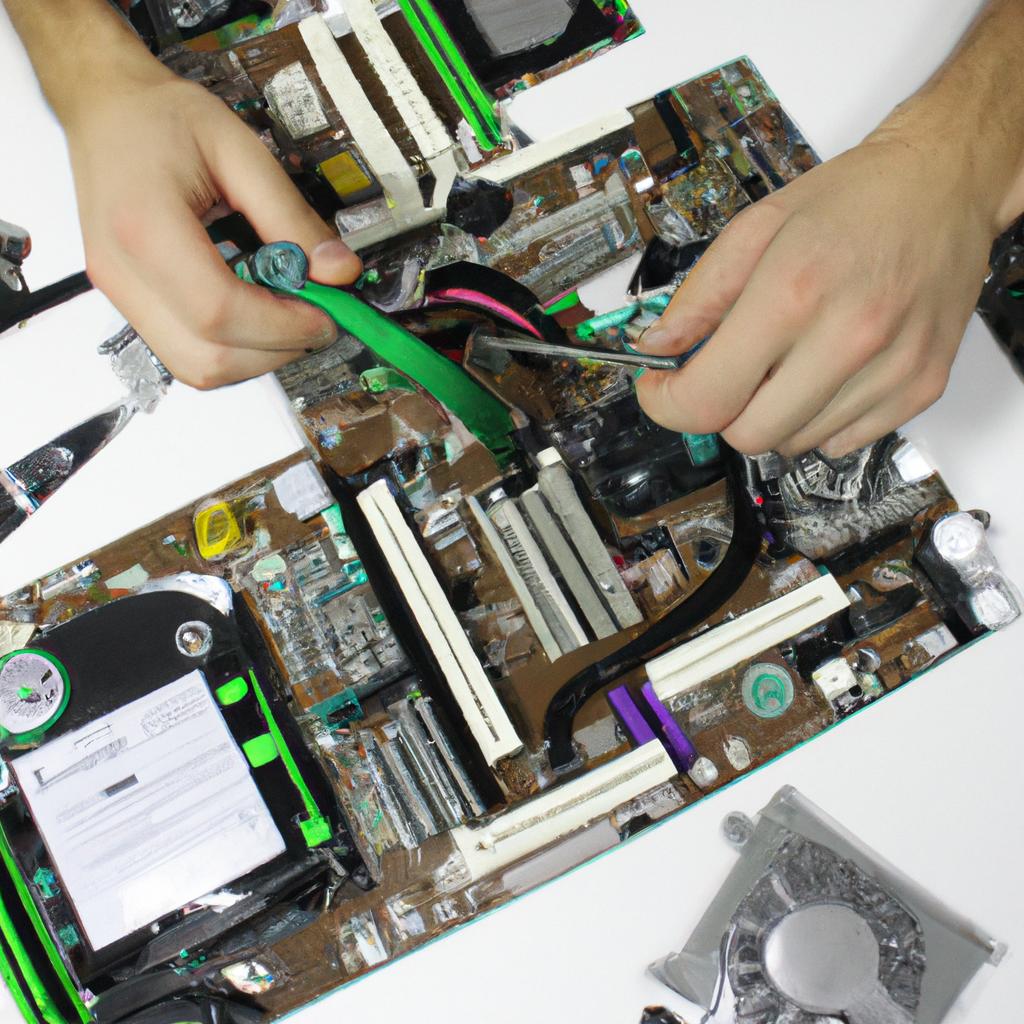The increasing reliance on computers and hardware in our daily lives has led to an urgent need for robust security features. In this article, we will explore the various security measures implemented in operating systems to protect sensitive data and ensure the integrity of computer systems. To illustrate the importance of these security features, let us consider a hypothetical scenario: imagine a large corporation that stores vast amounts of customer information such as personal details, financial records, and proprietary business data. Without adequate security measures in place, this valuable information could be compromised by malicious actors seeking unauthorized access or exploitation.
Operating systems play a crucial role in maintaining the overall security of computers and hardware. By acting as an intermediary between software applications and underlying hardware components, operating systems implement a range of protective mechanisms. These include user authentication protocols, file encryption algorithms, and secure boot processes that prevent unauthorized modifications during system startup. Additionally, modern operating systems incorporate features like firewall protection, intrusion detection systems (IDS), and virtual private networks (VPNs) to safeguard against external threats such as network attacks or data breaches. Throughout this article, we will delve into each of these security measures and examine how they contribute to creating a secure computing environment.
User Authentication
One of the fundamental security features in computer systems and hardware is user authentication. User authentication ensures that only authorized individuals can access a system or its resources, protecting against unauthorized access and potential data breaches. To illustrate the importance of user authentication, consider the following hypothetical scenario: A company’s confidential financial information is stored on a network server accessible to all employees. Without proper user authentication measures in place, any employee could potentially gain unrestricted access to this sensitive data, compromising both the company’s integrity and privacy.
To enhance security, user authentication typically involves multiple factors for verification. These factors fall into three categories: knowledge-based (something you know), possession-based (something you have), and inherence-based (something you are). By combining these factors, the level of confidence in an individual’s identity increases significantly. For instance:
- Knowledge-based factor: requiring users to enter a unique username/password combination.
- Possession-based factor: utilizing smart cards or physical tokens that generate one-time passwords.
- Inherence-based factor: employing biometric identifiers such as fingerprints or facial recognition.
These techniques provide additional layers of protection by ensuring that even if one factor is compromised, there are still other barriers preventing unauthorized access. Moreover, some systems implement multi-factor authentication (MFA) where more than one factor needs to be verified simultaneously for increased security.
In summary, user authentication plays a critical role in safeguarding computers and hardware from unauthorized access. Implementing robust authentication methods reduces the risk of data breaches and helps maintain confidentiality and privacy. The next section will explore another important security feature known as “Secure Boot,” which focuses on verifying the integrity of operating system components during startup.
Please note that while bullet points and tables can evoke emotional responses from audiences when used effectively, their primary purpose is to present information concisely and clearly rather than solely generating emotions.
Secure Boot
Section H2: Secure Boot
Continuing our exploration of security features in computers and hardware, we now shift our focus to the concept of secure boot. To illustrate its importance, let us consider a hypothetical scenario where an unauthorized user attempts to gain access to a computer system by tampering with the boot process. By understanding the significance of secure boot and how it enhances overall system security, we can better appreciate its role in safeguarding sensitive data.
Secure Boot Explained:
Secure boot is a fundamental feature implemented in modern operating systems that ensures only trusted software components are loaded during the startup process. It works by verifying the integrity and authenticity of each component before allowing them to run on the system. This verification process helps prevent malicious or compromised code from compromising system security. One notable example of this is the Unified Extensible Firmware Interface (UEFI) standard, which incorporates secure boot functionality into many contemporary systems.
To further emphasize the importance of secure boot, let us delve into some key benefits it provides:
- Protection against rootkits and malware: By verifying the digital signatures of bootloader components, secure boot prevents unauthorized modifications that could potentially introduce malware or stealthy rootkits.
- Resistance to firmware-level attacks: Secure boot safeguards against attackers attempting to compromise low-level firmware components during system initialization.
- Enhanced trustworthiness for remote attestation: Remote attestation allows external entities (such as network servers) to verify the integrity and isolation level of a device. With secure boot enabled, these attestations become more trustworthy due to heightened assurance regarding software integrity.
- Support for chain-of-trust model: Secure boot establishes a chain-of-trust model wherein each subsequent stage verifies the previous one. This approach creates layers of protection that ensure only authorized software runs at each step.
Table – Benefits of Secure Boot:
| Benefit | Description |
|---|---|
| Protection against malware | Prevents unauthorized modifications that may introduce malware or rootkits |
| Resistance to firmware attacks | Safeguards against attempts to compromise low-level firmware components |
| Enhanced remote attestation | Increases trustworthiness of external verification regarding software integrity |
| Chain-of-trust model support | Establishes layered protection ensuring only authorized software is executed |
Having explored the significance of secure boot in bolstering system security, we now turn our attention to another crucial aspect: data encryption. By employing robust encryption techniques, organizations can ensure that sensitive information remains confidential and protected from unauthorized access.
Data Encryption
Building upon the foundation of secure boot, an essential security feature implemented within operating systems, an equally crucial measure to protect sensitive data is data encryption. By encrypting data, it becomes unreadable to unauthorized users, ensuring confidentiality even if the information falls into the wrong hands.
Data Encryption:
To illustrate the significance of data encryption, let us consider a hypothetical scenario involving a company that handles confidential client information. One day, an employee accidentally misplaces their laptop containing critical financial records and personal details of hundreds of customers. Without proper encryption measures in place, this incident could potentially lead to severe consequences such as identity theft or financial fraud.
To mitigate such risks and safeguard sensitive information effectively, operating systems offer robust data encryption mechanisms. These features work by converting plaintext data into ciphertext using complex algorithms that can only be decrypted with an authorized key or password. The use of strong encryption methods ensures that even if an attacker gains access to encrypted files or devices, deciphering them without authorization remains virtually impossible.
The implementation of data encryption provides several benefits for securing computer systems and hardware:
- Confidentiality: Encrypted data ensures that only authorized individuals with valid decryption keys can access its contents.
- Integrity: Encryption techniques also verify the integrity of stored or transmitted information by detecting any alterations made during transit or storage.
- Compliance: Many industries have specific regulations regarding data protection. Employing encryption helps organizations meet these compliance requirements.
- Peace of Mind: Encrypting sensitive information offers peace of mind knowing that even in cases of unauthorized access, the content remains inaccessible to potential adversaries.
| Benefit | Description |
|---|---|
| Confidentiality | Ensures that only authorized individuals can access encrypted data |
| Integrity | Verifies the integrity of information by detecting any alterations during transit or storage |
| Compliance | Helps organizations meet industry-specific regulations regarding data protection |
| Peace of Mind | Provides reassurance that sensitive information remains inaccessible to potential adversaries even in unauthorized access scenarios |
In summary, data encryption plays a pivotal role in protecting confidential information. By converting plaintext into ciphertext through complex algorithms and utilizing decryption keys, operating systems ensure that only authorized individuals can access critical data. This security measure offers several advantages such as confidentiality, integrity verification, compliance with regulations, and peace of mind for both individuals and organizations.
Moving forward from data encryption, another vital aspect of computer and hardware security is firewall protection. Firewalls act as a barrier between internal networks and external threats, effectively monitoring incoming and outgoing traffic to safeguard against unauthorized access.
Firewall Protection
Building upon the importance of data encryption, another crucial security feature in operating systems is firewall protection. By establishing a barrier between an internal network and external networks, firewalls play a pivotal role in safeguarding computers and hardware against unauthorized access.
Firewall Protection:
To illustrate the significance of firewall protection, let’s consider a hypothetical scenario. Imagine a large multinational corporation that stores sensitive customer information on its servers. Without proper firewall measures in place, these servers would be vulnerable to cyberattacks aiming to steal or manipulate this valuable data. However, by implementing robust firewall software and hardware solutions, such as Next-Generation Firewalls (NGFW), organizations can protect their networks from malicious activities while allowing legitimate traffic to pass through.
Effective firewall protection incorporates several key elements:
- Access Control: Firewalls filter incoming and outgoing network traffic based on predefined rules, blocking potentially harmful connections while permitting authorized ones.
- Network Address Translation (NAT): This technique modifies IP addresses within packets to hide internal network structures from external entities, preventing direct access to devices behind the firewall.
- Application Filtering: Firewalls can analyze application-layer protocols to detect suspicious behaviors or prevent unauthorized use of specific applications.
- Intrusion Prevention System (IPS): IPS functions alongside firewalls by actively detecting potential threats before they enter the system, providing an additional layer of defense.
Table showcasing different types of firewalls:
| Type | Description | Example |
|---|---|---|
| Packet-filtering | Examines packet headers for source and destination addresses, ports, and protocols; filters based on predetermined rules | Cisco ASA |
| Stateful inspection | Tracks active connections’ state information; permits only valid packets | Palo Alto Networks |
| Proxy-based | Acts as an intermediary between clients and servers, analyzing traffic at the application layer | Blue Coat ProxySG |
| Next-Generation Firewalls (NGFW) | Combines traditional firewall functionality with advanced features such as intrusion prevention and deep packet inspection | Fortinet FortiGate |
The importance of a robust security infrastructure extends beyond firewalls. An equally vital component is Intrusion Detection Systems (IDS), which proactively monitor networks for potential threats and help detect unauthorized access attempts or suspicious activities.
Intrusion Detection System
Intrusion Detection System (IDS)
To further enhance the security of computer systems, operating systems often employ an Intrusion Detection System (IDS). An IDS is a software or hardware component that monitors network activity for suspicious behavior and potential threats. It serves as an additional layer of defense against unauthorized access and malicious activities.
Imagine a scenario where an organization’s network experiences unusually high traffic during non-business hours. This could be indicative of a potential intrusion attempt by an external attacker. In such cases, an IDS would analyze the incoming traffic patterns, compare them with established baselines, and raise alarms if any anomalies are detected.
An IDS provides several key benefits:
- Real-time monitoring: Constantly scanning network traffic allows for immediate detection of potential intrusions, enabling timely responses to mitigate risks.
- Identification of attack signatures: By comparing observed patterns with known attack signatures, an IDS can identify specific types of attacks being attempted on the system.
- Log analysis: The system logs generated by an IDS provide valuable information about past incidents, aiding in forensic investigations and strengthening proactive defenses.
- Enhanced incident response capabilities: When integrated into a broader security framework, an IDS can trigger automated actions or alert human operators to respond effectively to ongoing cyber threats.
| Pros | Cons |
|---|---|
| Early threat detection | False positives |
| Real-time alerts | Resource-intensive |
| Enhanced incident response | Requires regular updates |
| Forensic investigation support | Potential evasion by sophisticated attackers |
In summary, the implementation of an Intrusion Detection System within operating systems plays a vital role in safeguarding computer networks from unauthorized access. Through real-time monitoring, identification of attack signatures, log analysis, and enhanced incident response capabilities, organizations can strengthen their overall cybersecurity posture.
Transitioning into the next section discussing “Secure Firmware Updates,” it is essential to consider the importance of maintaining system integrity and protecting against potential vulnerabilities introduced through firmware updates.
Secure Firmware Updates
Building upon the importance of intrusion detection systems, another crucial aspect of ensuring robust security within computer systems is through secure firmware updates. By implementing effective mechanisms to update firmware securely, operating systems can prevent unauthorized access and protect against potential vulnerabilities.
Example:
To illustrate the significance of secure firmware updates, let us consider a hypothetical case study involving an organization that failed to regularly update their system’s firmware. Due to this negligence, they unknowingly left a vulnerability unpatched for an extended period. Exploiting this weakness, hackers gained unauthorized access to critical data stored on the organization’s servers, resulting in severe financial losses and compromised sensitive information.
Importance of Secure Firmware Updates:
- Mitigation of Vulnerabilities: Regularly updating firmware helps address known security flaws by patching vulnerabilities that could be exploited by attackers.
- Protection Against Malware: Updating firmware ensures that devices have the latest security measures in place, offering enhanced resistance against malware attacks.
- Improved Device Performance: Aside from bolstering security, firmware updates often include performance enhancements and bug fixes that optimize device functionality.
- Compliance with Industry Standards: Various regulatory frameworks require organizations to maintain up-to-date software and hardware components as part of their compliance efforts.
- Ensuring your system’s safety against cyber threats
- Upholding confidentiality and protecting sensitive information
- Preventing financial losses due to unauthorized access
- Maintaining trust with customers or clients by demonstrating commitment towards cybersecurity
Table – Impact of Secure Firmware Updates:
| Benefits | Description |
|---|---|
| Enhanced Security | Protects against potential vulnerabilities and strengthens defenses |
| Reduced Risk | Minimizes the likelihood of successful cyberattacks |
| Improved Performance | Optimizes device functionality and resolves bugs |
| Regulatory Compliance | Ensures adherence to industry standards and regulations |
By prioritizing secure firmware updates, organizations can significantly enhance the security posture of their computer systems. Regularly patching vulnerabilities through these updates helps prevent unauthorized access, protect sensitive information, and minimize financial losses arising from cyberattacks. Such proactive measures ensure compliance with industry standards while maintaining trust with customers or clients in an increasingly interconnected digital landscape.





